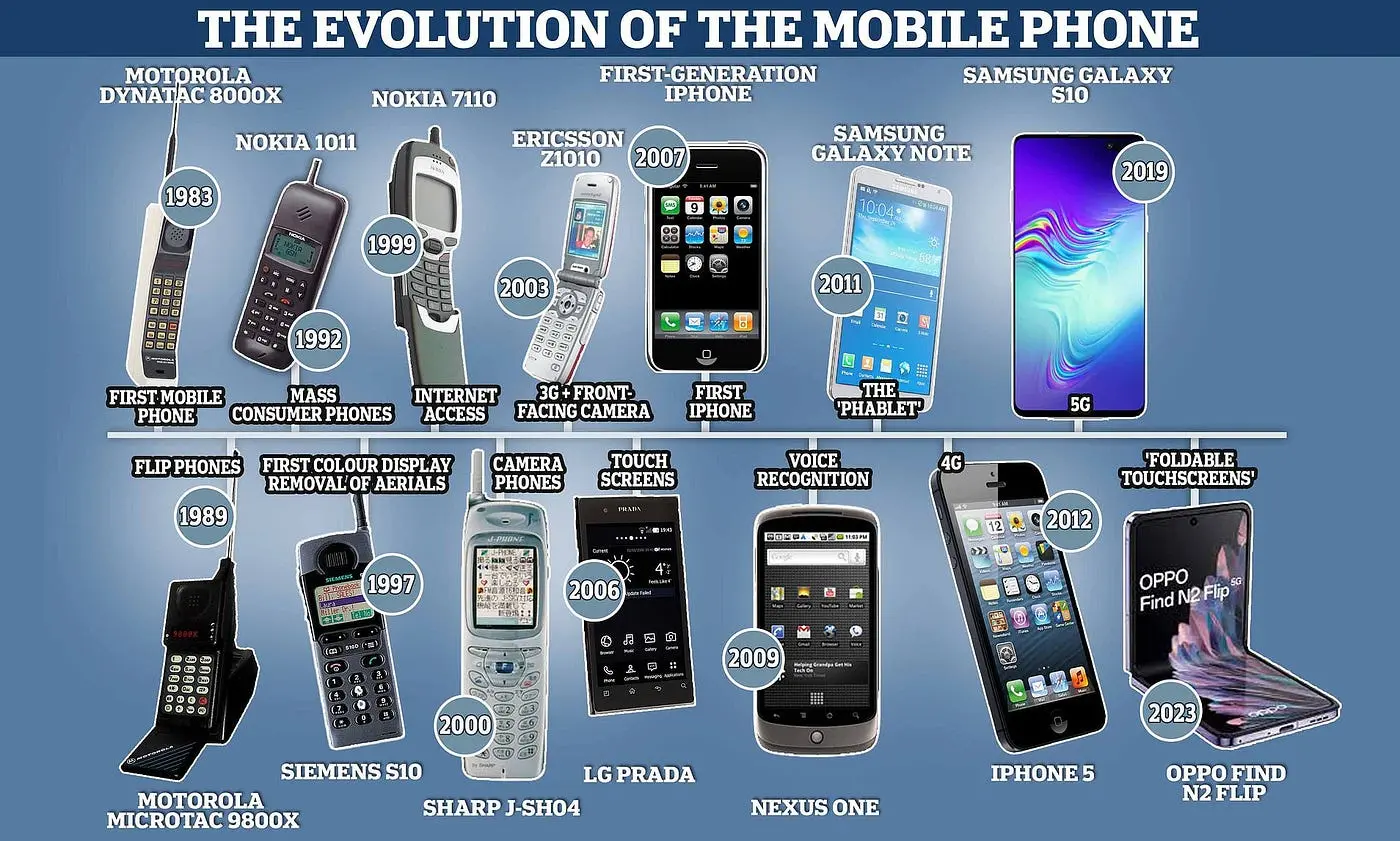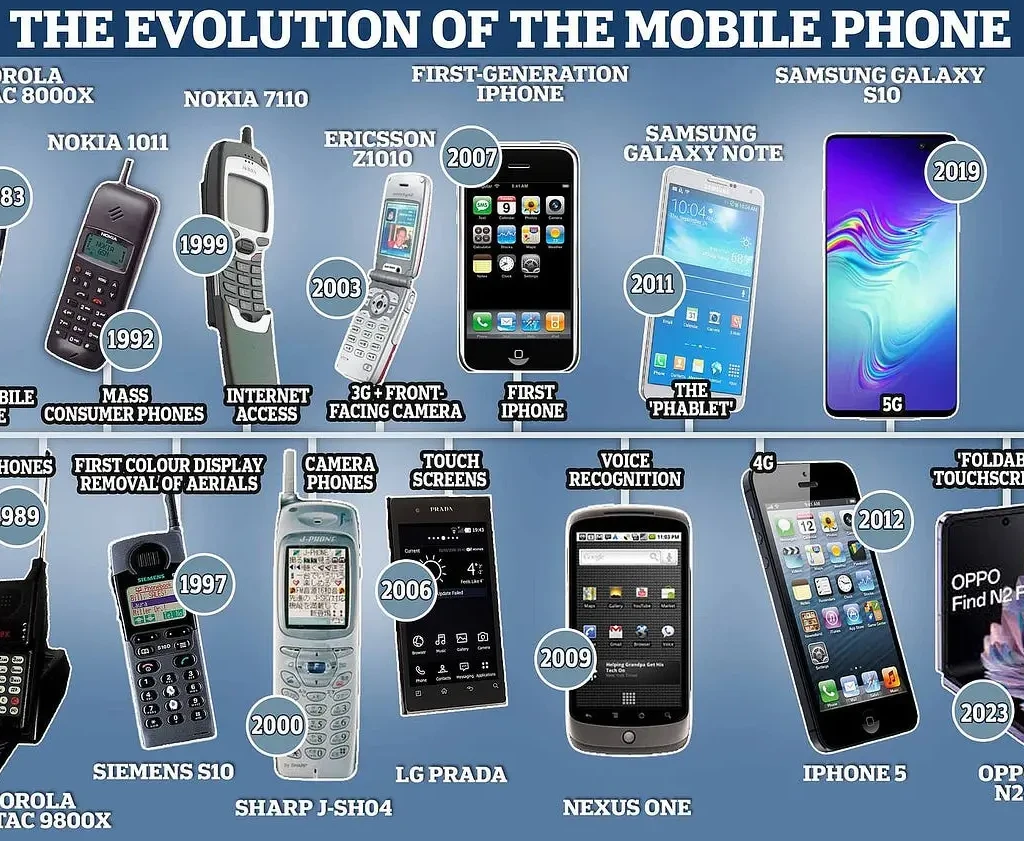Introduction
Can you imagine holding a phone that weighed almost a kilogram and was nearly the size of a brick? Back in 1983, the Motorola DynaTAC (an abbreviation of Dynamic Adaptive Total Area Coverage) 8000X was just that—a giant, expensive beast of a phone. Fast forward to 2025, and now we have foldable smartphones that fit in your pocket yet unfold into tablets. That’s a wild ride, isn’t it?

This journey from brick to foldable isn’t just about hardware changes. It tells a story of human innovation, cultural shifts, and how technology shapes the way we live. Let’s take a nostalgic and exciting look at the evolution of mobile phones and see what the future might hold.
1. The Era of Brick Phones (1980s–90s)
The journey began with the Motorola DynaTAC 8000X, launched in 1983. Weighing 2.5 pounds (1.1 kg) and costing around $4,000, it could only give you 30 minutes of talk time. Still, it was groundbreaking.

Why? Because it was the first truly portable mobile phone. Having one was a status symbol. You’d see businessmen and movie characters flaunting it like gold. But let’s be real—these phones were huge, had terrible battery life, and offered only basic calling features.
You may also want to read How Students Are Balancing School, Side Hustles, and Sanity
2. Flip & Feature Phones (1990s–Early 2000s)

Then came the era of flip phones. Remember the Motorola StarTAC? It was sleek, compact, and flipping it open made you feel like a secret agent. By the time Motorola Razr V3 dropped in 2004, phones had become fashion statements.
Feature phones followed, giving us color screens, polyphonic ringtones, and simple games like Snake. Nokia was king during this time. But as texting and mobile internet started gaining popularity, these phones began to fall short.
So why did flip phones die out? Because smartphones made them feel like toys. Touchscreens, apps, and better connectivity were just too powerful to ignore.
3. The Smartphone Revolution (Mid-2000s–2010s)
The IBM Simon (1992) was technically the first smartphone, but it wasn’t until Apple released the iPhone in 2007 that the world changed. It was like going from horse-and-carriage to a Tesla overnight.

With the rise of 3G and 4G, phones became mini-computers. You could browse the internet, take amazing pictures, play games, and download apps. The smartphone became the ultimate Swiss Army knife.
Let’s not forget Android, which offered users more customization. Together, iPhone and Android reshaped the mobile landscape forever.
4. The Phablet Phase (2011–2015)
Somewhere along the line, someone said, “Let’s make phones bigger again!” And so, phablets were born—a mix of phones and tablets. Think Samsung Galaxy Note series.

These large-screen devices were perfect for watching videos, reading, and even drawing. They were especially helpful for older users who preferred bigger fonts. Though some people mocked them initially, phablets carved out a solid niche.
5. Dawn of Foldables (2018–Now)

Foldables took things to the next level. Concepts like the Nokia Morph and Polymer Vision Readius teased the future, but it was the Royole FlexPai in 2018 that actually hit the market first.
Then came the big guns: Samsung Galaxy Fold, Galaxy Z Flip, Huawei Mate X. These phones could switch between a phone and tablet mode, offering versatility we’d never seen before.
The tech was mind-blowing, but not without its flaws. More on that in a sec.
6. Benefits & Challenges of Foldables
Pros:
- Multitasking: Open two apps side by side.
- Compactness: Large screen when needed, pocket-sized when not.
- Wow Factor: Admit it, foldables look cool.
Cons:
- Durability: Screens crease, hinges wear out.
- High Price: Not everyone can drop $1,800 on a phone.
- App Compatibility: Some apps don’t play well with foldable screens.
Are foldable phones worth it? For tech lovers, yes. For everyday users, maybe not just yet.
7. What’s Next? The Future of Mobile Form Factors
The mobile world doesn’t stop at foldables. We’re already seeing:
- Rollable Screens: LG teased one before exiting the phone biz.
- Holographic Displays: Imagine 3D FaceTime chats.
- Under-display Cameras: No more notches or holes.
- AI Integration: Phones that predict what you need before you ask.
- 5G/6G: Faster speeds mean more possibilities.
- AR/VR: Phones may become our gateway to mixed reality.
Evolution of Mobile Phones Timeline
Let’s map it out:
- 1983: Motorola DynaTAC (Brick Phone)
- 1996: Motorola StarTAC (First Flip Phone)
- 2000s: Nokia Feature Phones
- 2007: Apple iPhone
- 2011: Samsung Galaxy Note (Phablet)
- 2018: Royole FlexPai (First Foldable)
- 2020s: Samsung Z Series, Huawei Foldables
Evolution of Mobile Phones Images
A picture is worth a thousand words. Make sure to add visuals to your blog—showing the size and style differences between generations. Compare the 80s bricks to modern Z Flips side-by-side.
Evolution of Mobile Phones Video
Evolution of Mobile Phones Form Factors
We’ve seen:
- Brick
- Flip
- Slider
- Bar
- Touchscreen
- Phablet
- Foldable
Each form factor reflected the needs and desires of the time. What’s next? Something we haven’t even imagined yet.
Evolution of Mobile Phones: Brick, Flip, Smartphone, Foldable
This journey mirrors our desire for more convenience, style, and function. From bulky hardware to sleek, multipurpose devices, it’s been a constant race to pack more power into less space.
What Was the First Foldable Phone?
It was the Royole FlexPai, launched in 2018. Although not perfect, it opened the doors for bigger brands to explore the foldable space. Samsung quickly followed with the Galaxy Fold.
How Did Mobile Phones Evolve?
They evolved from single-function, bulky gadgets to sleek, powerful mini-computers. Each step forward was driven by advances in battery tech, display tech, and wireless connectivity.
Why Did Flip Phones Die Out?
They were outclassed. Smartphones offered internet, apps, better cameras, and more functionality. People wanted more than just calls and texts. Simplicity lost to versatility.
Are Foldable Phones Worth It?
If you love cutting-edge tech and can afford it, yes. They’re fun, functional, and futuristic. But for average users, durability and price are still dealbreakers.
Conclusion
The mobile phone has come a long way from the bulky bricks of the 80s to today’s slick foldables. Each era brought innovation that changed how we communicate, work, and live.
Now, over to you. What mobile phone evolution blew your mind the most? Do you think foldables are the future, or just a flashy trend? Let’s chat in the comments!
FAQs
1. Who invented the first mobile phone?
Martin Cooper of Motorola invented the first mobile phone in 1973, but it wasn’t commercially available until 1983.
2. Which phone had the first touchscreen?
The IBM Simon, released in 1992, was the first phone with a touchscreen.
3. Are flip phones still available?
Yes! Modern flip phones with smart features, like the Galaxy Z Flip, are making a comeback.
4. What is the most sold mobile phone ever?
The Nokia 1100 holds that title with over 250 million units sold.
5. Can foldable phones replace tablets?
They’re trying! Foldables are ideal for people who want both portability and a big screen.


